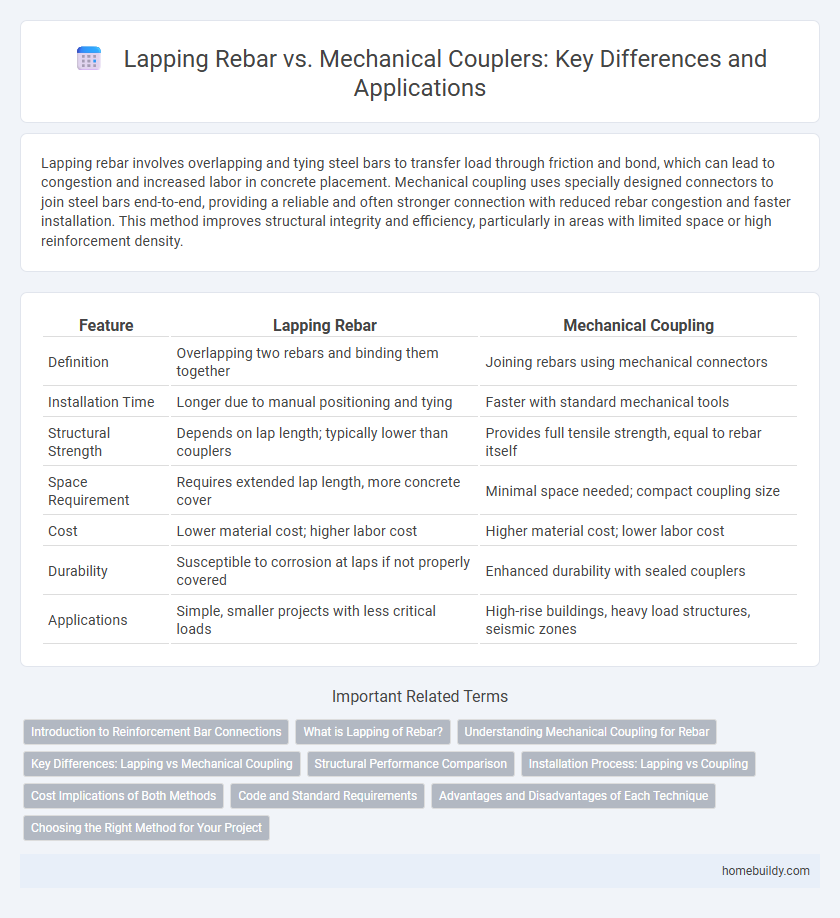Lapping rebar involves overlapping and tying steel bars to transfer load through friction and bond, which can lead to congestion and increased labor in concrete placement. Mechanical coupling uses specially designed connectors to join steel bars end-to-end, providing a reliable and often stronger connection with reduced rebar congestion and faster installation. This method improves structural integrity and efficiency, particularly in areas with limited space or high reinforcement density.
Table of Comparison
| Feature | Lapping Rebar | Mechanical Coupling |
|---|---|---|
| Definition | Overlapping two rebars and binding them together | Joining rebars using mechanical connectors |
| Installation Time | Longer due to manual positioning and tying | Faster with standard mechanical tools |
| Structural Strength | Depends on lap length; typically lower than couplers | Provides full tensile strength, equal to rebar itself |
| Space Requirement | Requires extended lap length, more concrete cover | Minimal space needed; compact coupling size |
| Cost | Lower material cost; higher labor cost | Higher material cost; lower labor cost |
| Durability | Susceptible to corrosion at laps if not properly covered | Enhanced durability with sealed couplers |
| Applications | Simple, smaller projects with less critical loads | High-rise buildings, heavy load structures, seismic zones |
Introduction to Reinforcement Bar Connections
Reinforcement bar connections are essential for maintaining structural integrity in concrete construction. Lapping rebar involves overlapping steel bars for a specified length to transfer loads through bond stress, while mechanical coupling uses specialized connectors to join bars end-to-end, providing a direct, high-strength connection. Mechanical couplers offer advantages in reducing congestion and ensuring consistent load transfer, especially in seismic or high-load applications.
What is Lapping of Rebar?
Lapping of rebar refers to the process of overlapping two reinforcement bars to transfer loads effectively by ensuring continuity in tensile strength. This method involves placing bars parallel with a specified overlap length, typically measured as a multiple of the bar diameter, to achieve proper bonding through concrete. Lapping is commonly used in construction for splicing and extending rebar when mechanical coupling is not feasible or cost-effective.
Understanding Mechanical Coupling for Rebar
Mechanical coupling for rebar provides a reliable and efficient connection method by using threaded or swaged couplers to join reinforcement bars, eliminating the need for overlapping lengths required in traditional lapping. This technique ensures consistent structural integrity and load transfer across splices, optimizing material usage and reducing congestion in concrete elements. Understanding mechanical couplings involves recognizing their advantages in enhancing joint strength, minimizing rebar congestion, and improving construction speed compared to conventional lapping methods.
Key Differences: Lapping vs Mechanical Coupling
Lapping rebar involves overlapping two reinforcement bars and binding them with wire to transfer load, relying on sufficient overlap length to ensure structural continuity. Mechanical coupling uses specially designed connectors to join bars end-to-end, providing higher tensile strength and reducing lap length requirements. Key differences include installation time, structural performance, and space efficiency, with mechanical coupling offering improved load transfer and reduced congestion compared to traditional lapping.
Structural Performance Comparison
Lapping rebar creates structural continuity through overlapping bars, which relies on concrete bond strength and bar length for load transfer, potentially resulting in stress concentration zones. Mechanical coupling offers direct bar-to-bar connection via threaded or swaged couplers, ensuring uniform stress distribution and improved tensile capacity. Studies show mechanical couplers provide superior structural performance in seismic and high-load applications due to enhanced joint stiffness and reduced slippage.
Installation Process: Lapping vs Coupling
Lapping rebar requires overlapping lengths of steel bars, typically 40 to 60 times the bar diameter, ensuring proper load transfer through direct contact and securing with tie wires. Mechanical coupling involves joining bars using threaded or swaged couplers, offering faster installation with precise alignment and reduced congestion in congested reinforcement areas. While lapping demands more material and space, coupling provides a more efficient and reliable method for connecting rebars with less labor and improved structural integrity.
Cost Implications of Both Methods
Lapping rebar involves overlapping two bars and tying them together, which can increase labor costs due to the additional time and workforce required, especially in congested areas. Mechanical coupling, while often more expensive in initial material and device costs, reduces installation time and labor intensity, leading to potential overall cost savings on large or complex projects. Choosing between lapping and mechanical coupling depends on project scale, site conditions, and labor cost efficiency to optimize reinforcement bar connection expenses.
Code and Standard Requirements
Lapping rebar must comply with code specifications such as ACI 318, which mandates minimum lap lengths based on bar diameter, concrete strength, and rebar grade to ensure adequate load transfer. Mechanical coupling, governed by standards like ASTM A108 and ISO 15835, requires certification of couplers to achieve performance equivalence to continuous reinforcing bars under tensile and fatigue loads. Both methods demand adherence to inspection procedures and quality control measures outlined in relevant structural codes to maintain structural integrity and safety.
Advantages and Disadvantages of Each Technique
Lapping rebar offers simplicity and cost-effectiveness by overlapping bars to transfer load without special equipment, but it increases congestion and requires longer overlap lengths that can reduce concrete placement quality. Mechanical coupling provides a more compact connection with higher tensile strength and less bar congestion, improving structural integrity and allowing faster installation, though it involves higher initial costs and specialized labor. Choosing between lapping and mechanical coupling depends on project-specific factors like space constraints, budget, and required structural performance.
Choosing the Right Method for Your Project
Lapping rebar involves overlapping steel bars and tying them together to create a continuous reinforcement, ideal for simple projects with manageable bar diameters and lengths. Mechanical coupling uses specialized connectors to join bars end-to-end, providing superior tensile strength and reduced lap length, making it suitable for high-load structures and congested areas. Selecting the right method depends on factors like structural requirements, project complexity, space constraints, and budget, ensuring optimal performance and cost-efficiency.
Lapping Rebar vs Mechanical Coupling Infographic

 homebuildy.com
homebuildy.com